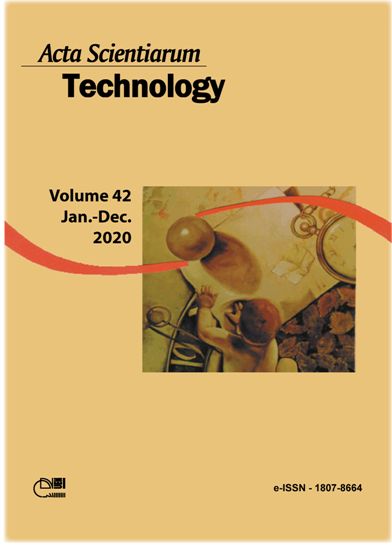In vitro and in vivo response of composites based on chitosan, hydroxyapatite and collagen
DOI:
https://doi.org/10.4025/actascitechnol.v42i1.41102Palavras-chave:
scaffolds; tissue regeneration; immunohistochemistry; chitosan; hydroxyapatite; collagen.Resumo
The goal of this study was to evaluate the in vitro cellular toxicity and biological behavior of new bone graft composites after subcutaneous implantation during remodeling and wound-healing processes. We developed composites based on hydroxyapatite (obtained by deproteinizing bovine bone), collagen (obtained from bovine tendon) and chitosan (obtained from gladii of the squid species Loligo), that were characterized by different techniques (X-ray, FT-IR, Thermogravimetry, DSC and SEM). Three biomaterials were evaluated here: B1 (collagen/chitosan/hydroxyapatite), B2 (collagen/hydroxyapatite) B3 (collagen/hydroxyapatite). For in vitro cytotoxicity tests, two cell lines were used: HEp human larynx tumor cells (ATCC-CCL-23) and VERO cells from African green monkey (Cercopithecus aethiops). These toxicity tests demonstrated that the evaluated composites are not toxic. In biocompatibility tests, the results of a histological analysis showed that all three biomaterials present a low inflammatory tissue reaction. The tissue response was most favorable for sample B3, followed by B2 and B1, in that order. Based on these results, we conclude that all three biomaterials show good biocompatibility and no evidence of cytotoxicity; thus, these materials represent good candidates for tissue and graft engineering for use in bone regeneration.
Downloads
Downloads
Publicado
Como Citar
Edição
Seção
Licença
DECLARAÇíO DE ORIGINALIDADE E DIREITOS AUTORAIS
Declaro que o presente artigo é original, não tendo sido submetido í publicação em qualquer outro periódico nacional ou internacional, quer seja em parte ou em sua totalidade.
Os direitos autorais pertencem exclusivamente aos autores. Os direitos de licenciamento utilizados pelo periódico é a licença Creative Commons Attribution 4.0 (CC BY 4.0): são permitidos o compartilhamento (cópia e distribuição do material em qualqer meio ou formato) e adaptação (remix, transformação e criação de material a partir do conteúdo assim licenciado para quaisquer fins, inclusive comerciais.
Recomenda-se a leitura desse link para maiores informações sobre o tema: fornecimento de créditos e referências de forma correta, entre outros detalhes cruciais para uso adequado do material licenciado.



















